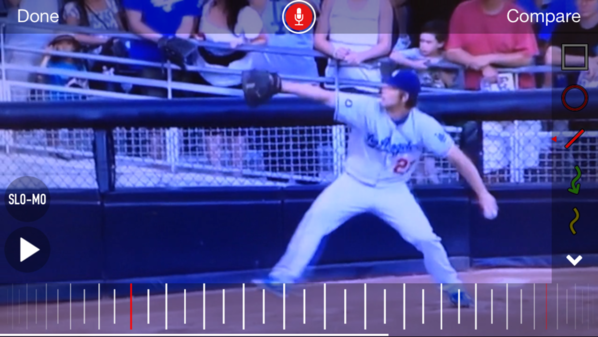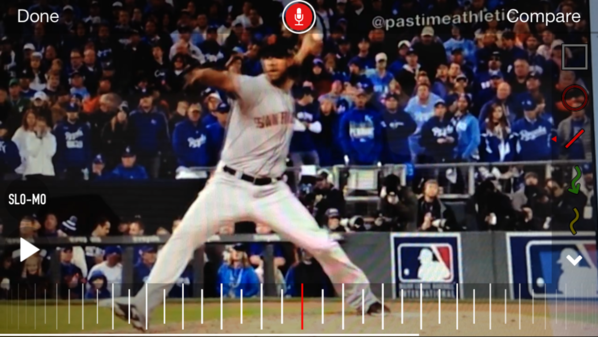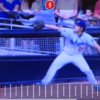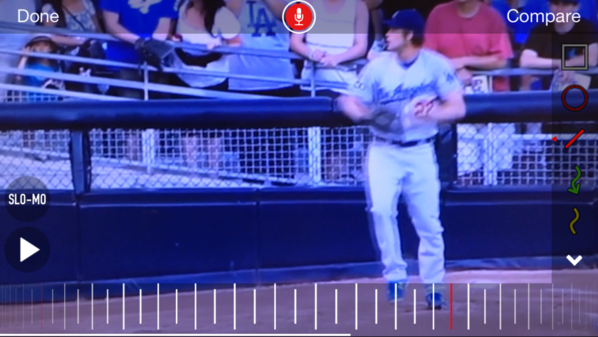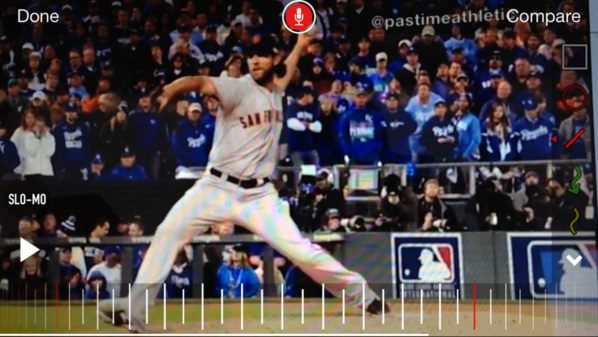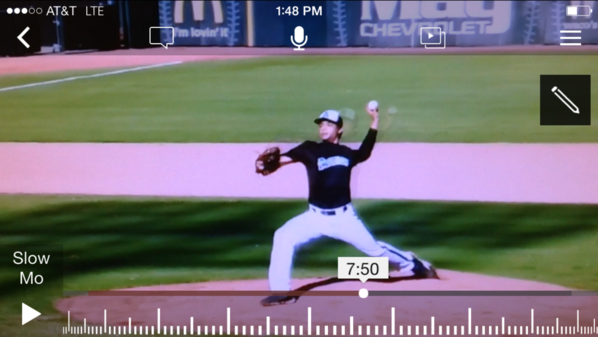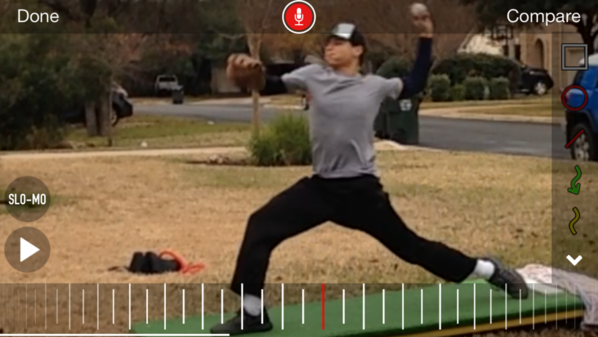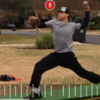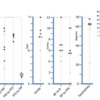Replies sorted oldest to newest
Originally Posted by jolietboy:
Wondering if anyone else out there times (and measures) their pitcher's strides to the plate. If PG reads this I would be curious to know if it is something they look at. There are a number of ways to time it I supose but for velocity sake I would think from forward momentum to land and to release would be most important. Thoughts?
I’m all for tracking just about everything, but I’m lost on this one. Are you saying the velocity a pitcher’s body moves toward the plate is relative to the ball release velocity?
Originally Posted by jolietboy:
Wondering if anyone else out there times (and measures) their pitcher's strides to the plate. If PG reads this I would be curious to know if it is something they look at. There are a number of ways to time it I supose but for velocity sake I would think from forward momentum to land and to release would be most important. Thoughts?
I’m all for tracking just about everything, but I’m lost on this one. Are you saying the velocity a pitcher’s body moves toward the plate is relative to the ball release velocity?
Absolutely. First generator of velocity actually. Long stride is important but the faster you can make that long stride the more power you deliver.
Originally Posted by jolietboy:
Wondering if anyone else out there times (and measures) their pitcher's strides to the plate. If PG reads this I would be curious to know if it is something they look at. There are a number of ways to time it I supose but for velocity sake I would think from forward momentum to land and to release would be most important. Thoughts?
I’m all for tracking just about everything, but I’m lost on this one. Are you saying the velocity a pitcher’s body moves toward the plate is relative to the ball release velocity?
Absolutely. First generator of velocity actually. Long stride is important but the faster you can make that long stride the more power you deliver.
In fact there is a study out there somewhere that found a very close coorelation between time from highest apex of the knee kick and foot strike to velocity. It was eerily consistent. I'll see if I can't find that.
If you want some science backing this theory up, read some of Brent Pourciau at TopVelocity.net. Pretty good information for thought.
Originally Posted by jolietboy:
Wondering if anyone else out there times (and measures) their pitcher's strides to the plate. If PG reads this I would be curious to know if it is something they look at. There are a number of ways to time it I supose but for velocity sake I would think from forward momentum to land and to release would be most important. Thoughts?
I’m all for tracking just about everything, but I’m lost on this one. Are you saying the velocity a pitcher’s body moves toward the plate is relative to the ball release velocity?
Absolutely. First generator of velocity actually. Long stride is important but the faster you can make that long stride the more power you deliver.
In fact there is a study out there somewhere that found a very close coorelation between time from highest apex of the knee kick and foot strike to velocity. It was eerily consistent. I'll see if I can't find that.
thanks root! I am all about science independent study numbers and video. I think this is a fairly new or at least secerely underused measurement so I was wondering what others have done with it. I plan to put a board painted white with black lines behind the mound (like a giant ruler) then put an I pad with a stopwatch app on in front of the mound. Then video. By freeze framing I am hoping we can clearly see stopwatch. Freeze at forward momentum and at landing. Simple subtraction gives the time.
I am not too sure about this. Effective pitching is a summation of a bunch of complex movements ending with the release of the baseball. I am not sure I would want a pitcher thinking about generating the fastest stride to generate velocity. These may be touch points, but pitchers need "keys" that trigger them to repeat a delivery that is consistent and effective.At least for my son it is about drive foot placement, hip drive in a very specific way, landing foot position, arm break, glove side placement, and some other arm touch points. If simply driving to the plate faster equals higher velocity then everyone would just have to leap to the plate as fast as they could and they would throw hard.
I am not sure if I understand what would be done with the data to change behavior, and how it would be implemented. I am not an expert just an observer, but it seems like there are a lot of other things to focus on.
I am not too sure about this. Effective pitching is a summation of a bunch of complex movements ending with the release of the baseball. I am not sure I would want a pitcher thinking about generating the fastest stride to generate velocity. These may be touch points, but pitchers need "keys" that trigger them to repeat a delivery that is consistent and effective.At least for my son it is about drive foot placement, hip drive in a very specific way, landing foot position, arm break, glove side placement, and some other arm touch points. If simply driving to the plate faster equals higher velocity then everyone would just have to leap to the plate as fast as they could and they would throw hard.
I am not sure if I understand what would be done with the data to change behavior, and how it would be implemented. I am not an expert just an observer, but it seems like there are a lot of other things to focus on.
big leaguers are around .7 seconds so that is a goal. But they also have longer strides so that is part of the equation as well. I would challenge them to beat their own numbers while maintaining their mechanics. And if you think about it pitching is kind of a lateral leap. And there is a lot of data showing lateral jump has a direct correlation to velocity.
If you want some science backing this theory up, read some of Brent Pourciau at TopVelocity.net. Pretty good information for thought.
good food for thought there. I have read his stuff. Also talked a lot about it to my sons trainer who interned for cressey. And although he is far from my favorite guru dick mills talks a lot about it as well.
Speed down the mound certainly equates into velocity...the more explosive you move out of hand break, the longer the stride....the more speed / momentum into back hip rotation,... the more elastic energy you should develop (i.e. hip / shoulder separation)....assuming all has sequenced up the chain of movements..... Having said that, you are not going to get a CC Sabathia, moving the same as a Roy Oswalt. A lot of this has to do with body build.
Jolieboy,
When you hear about the 0.7 secs, this is time to the plate with runners on base with a slide step, which is important for holding the runners but actually messes up mechanics.
I know my son's previous pitching coaches talk about "tempo and intent to throw hard" but I have never heard anything about timing drive to contact point. Not that it might be important, just never heard about it and not sure what and how you would change behavior based on a series of measurements.
I am not too sure about this. Effective pitching is a summation of a bunch of complex movements ending with the release of the baseball. I am not sure I would want a pitcher thinking about generating the fastest stride to generate velocity. These may be touch points, but pitchers need "keys" that trigger them to repeat a delivery that is consistent and effective.At least for my son it is about drive foot placement, hip drive in a very specific way, landing foot position, arm break, glove side placement, and some other arm touch points. If simply driving to the plate faster equals higher velocity then everyone would just have to leap to the plate as fast as they could and they would throw hard.
I am not sure if I understand what would be done with the data to change behavior, and how it would be implemented. I am not an expert just an observer, but it seems like there are a lot of other things to focus on.
Of course there's more to it, but momentum is a much ignored factor and it's a big one. Here's the analogy I like to use. Most tend to agree that velocity is more about body action than arm action - the arm and hand are the end of the kinetic chain. Picture yourself standing on top of a car moving down the road. The car hits a brick wall. Now, you are going to fly off that car, the only question is how fast are you going to fly off that car? Your coming off that car with a much greater velocity if the car is traveling 50mph than you are if it's going 20 mph. The baseball coming out of your hand is the same as you flying off that car. The minute you brace your body with the stride foot, stopping momentum just like the car hitting the wall, you have ended the forward momentum of your body and it is transferred to your arm and hand. When the arm and hand halt momentum, the ball flies out. It only follows (in fact must follow by the laws of physics) that the faster your body travels, the faster your arm travels and the faster the ball travels.
Is it the only important part of velocity? Of course not. But, it is one thing you can easily change assuming your velocity off the mound isn't that great to begin with.
Jolieboy,
When you hear about the 0.7 secs, this is time to the plate with runners on base with a slide step, which is important for holding the runners but actually messes up mechanics.
I know my son's previous pitching coaches talk about "tempo and intent to throw hard" but I have never heard anything about timing drive to contact point. Not that it might be important, just never heard about it and not sure what and how you would change behavior based on a series of measurements.
The .7 seconds he's talking about isn't time to the plate. No one gets .7 seconds time to the plate, by the way. 1.1 is a very fast slide step time to the plate.
I just saw BFS post or compare Lincecom vs Nolan Ryan, or a Jonathon Broxton vs a Bob Feller. I don't think it is something to worry about frankly, too many others to get right. JMO.
roothog - +1 on your explanation...you said it much better than I did.![]()
Pitchers that don't move as explosively as others, must sequence the momentum they do produce much more efficiently...so it is not an absolute for velocity, just another component in the equation.
Roothog,
I get what you are saying but say the difference between a fast stride vs a slow stride is what in MPH? 1 or 2 at max. So if I take a guy with a whip who snaps it at 100 vs 98 does this make a lot of difference? I don't see it. Certainly part of the teaching on throwing hard is about tempo.
Again I am not sure, but having been around pitchers and instructors for quite some time I am not sure how you are gong to measure this and then how are you going to implement meaningful change.
Let's break this down into 4 basic sequences:
1. stride down the mound (this is where speed can make a difference)
2. Hip rotation
3. trunk (shoulder rotation)
4. arm layback / ball release
All of the above sequences are influenced by the preceding sequence, and only happen after that preceding sequence stops, therefore if the first sequence (speed of stride down the mound is faster, than the last sequence will have more speed (ball release).
Roothog,
I get what you are saying but say the difference between a fast stride vs a slow stride is what in MPH? 1 or 2 at max. So if I take a guy with a whip who snaps it at 100 vs 98 does this make a lot of difference? I don't see it. Certainly part of the teaching on throwing hard is about tempo.
Again I am not sure, but having been around pitchers and instructors for quite some time I am not sure how you are gong to measure this and then how are you going to implement meaningful change.
Well, if you have a pitcher who already has good, quick explosive moves down the mound, you aren't going to create a lot of extra velocity. However, I have kids come to me all the time with this idea of a balancing at leg lift and then presenting a slow, deliberate movement down the mound. Those kids I can make quick progress with.
As far as measurement, I'm trying to find a pretty good study I found a while back. However it was (some help here?) measured time from the top of knee lift to foot strike of a decent sample of mlb pitchers and the correlation between those times and the corresponding velocity was pretty consistent.
Roothog, I get what you are saying, and some of my son's his early instructors talked to him about "intent to throw hard and tempo" which is what you are talking about. I think you can get his by getting a kid to stand in front of a mirror and drive tot he plate with quick and slow tempo and you will get what you are looking for.
What I have seen in in the past year and a half with my son who went from a mid to high 80's pitcher who is now sitting at 91-93 and a lot of this had to do with hip drive, drive foot placement, (like anything there was a lot more but this is the most visible difference) I think you can generate that velo with good hard hip drive, and work on this vs trying to time them down a mound.
Roothog, I get what you are saying, and some of my son's his early instructors talked to him about "intent to throw hard and tempo" which is what you are talking about. I think you can get his by getting a kid to stand in front of a mirror and drive tot he plate with quick and slow tempo and you will get what you are looking for.
What I have seen in in the past year and a half with my son who went from a mid to high 80's pitcher who is now sitting at 91-93 and a lot of this had to do with hip drive, drive foot placement, (like anything there was a lot more but this is the most visible difference) I think you can generate that velo with good hard hip drive, and work on this vs trying to time them down a mound.
I've had pretty good success with concentrating first on the lower body - fast explosive move down the mound and (I know this goes against the grain of a lot of traditional thought) getting the hips completely open by foot strike. Then I move to the upper body. For me, I've broken my teaching down into three main factors that I think, together, contribute 98% to velocity. Momentum down the hill, hip/shoulder separation, and max peak valgus angle (aka arm layback). The rest is fine tuning. Of the three, I find that arm lay back angle is the hardest to make any change with. It seems to me that may be the most genetically determined factor of the three.
Attached is a pretty good study. Although it focuses mostly on the effects of stride length, it also attempts to measure the importance of initial momentum in the kinetic chain.
Attachments
Roothog,
I get what you are saying but say the difference between a fast stride vs a slow stride is what in MPH? 1 or 2 at max. So if I take a guy with a whip who snaps it at 100 vs 98 does this make a lot of difference? I don't see it. Certainly part of the teaching on throwing hard is about tempo.
Again I am not sure, but having been around pitchers and instructors for quite some time I am not sure how you are gong to measure this and then how are you going to implement meaningful change.
Again I believe it can be more than 2mph. But if all other things are well refined it may be as little as 2 I suppose. How big of a difference is that? Huge. In mlb the offensive production dips significantly from 95 to 97. If you are a hs pitcher looking to be recruited by a good D1 the difference between 89 and 91 would be huge. Only in mlb is there a 'zone' where velocity doesn't seem to make much difference. From about 90 to 94 doesn't seem to make a huge statistical difference. Probably a lot of reasons for this beginning with the guy who only throws 90 is probably mlb because of incredible control or a wicked curveball etc. Also theory has it because there are so many pitchers in that range they are used to seeing it and that is the hitters timing sweetspot.
I am thinking that these would have secondary effect but for accuracy.
1 MPH = 1.47 ft/sec
Average Stride = 6 ft
0.7 secs = 5.8MPH
For every 0.1 sec difference you are talking about 1 MPH in average velo. However once foot strike happens linear velocity is converted into rotational. Also remember these are average numbers in actuality there is a velocity and acceleration curve.
I believe intent to throw hard and hip drive are huge in the velocity equation, so I would work on this first and worry about timing it maybe later.
I am thinking that these would have secondary effect but for accuracy.
1 MPH = 1.47 ft/sec
Average Stride = 6 ft
0.7 secs = 5.8MPH
For every 0.1 sec difference you are talking about 1 MPH in average velo. However once foot strike happens linear velocity is converted into rotational. Also remember these are average numbers in actuality there is a velocity and acceleration curve.
I believe intent to throw hard and hip drive are huge in the velocity equation, so I would work on this first and worry about timing it maybe later.
Actually, I don't time it. I want that momentum as fast as a pitcher of mine can give me, so I just teach quickening it. I'm not even sure I know anyone personally who does time it for training purposes. I was pointing out, that for study purposes, it has been timed and shown that there is a coorelation - the higher velocity pitchers recording quicker times to foot strike.
I also wanted to ask BOH what you mean when you say "hip drive." I think I know, and I have some strong aopinions on that, but don't want to comment without knowing we're talking about the same thing.
Brent doesn't talk about getting faster per se, his big thing is having the strength in the legs and core to be more explosive and increasing stride length due to that explosiveness. My son went to work with him for a week a couple years ago. We never fully implemented his techniques as we didn't have access to proper weight training. He believes heavily in Olympic lifts. I was afraid to have son do these without proper instruction and guidance. I will tell you that doing his medicine ball drills and working on increasing stride length definitely made a difference. This is very non-scientific, but I have watched my son pitch his entire life. When everything is sequenced correctly and his stride is long, he looks much more effortless. Our big takeaway is to use your lower half maximally. I believe that most everyone agrees this will reduce stress on arm. I'm not pushing his site, but the info would be explained much better there than what I am doing.
Brent doesn't talk about getting faster per se, his big thing is having the strength in the legs and core to be more explosive and increasing stride length due to that explosiveness. My son went to work with him for a week a couple years ago. We never fully implemented his techniques as we didn't have access to proper weight training. He believes heavily in Olympic lifts. I was afraid to have son do these without proper instruction and guidance. I will tell you that doing his medicine ball drills and working on increasing stride length definitely made a difference. This is very non-scientific, but I have watched my son pitch his entire life. When everything is sequenced correctly and his stride is long, he looks much more effortless. Our big takeaway is to use your lower half maximally. I believe that most everyone agrees this will reduce stress on arm. I'm not pushing his site, but the info would be explained much better there than what I am doing.
Assuming this is something that has basis in fact and is worthwhile, here’s where I have reservations. For every coach who fully understands it and has the capacity to teach it correctly, there’s gonna be 100 who try but teach it wrong, and 1,000 dads or players who try to do it on their own and really get it mucked up. So what happens to those players who get poor instruction or do it incorrectly on their own?
Is this the next magic potion to gain velocity, the cause of a new wave of pitching injuries, or something in between? Personally I don’t know because it’s a new thought to me, but I have to say that after many years on this earth I lean much more toward being careful than going into it full blast.
Assuming this is something that has basis in fact and is worthwhile, here’s where I have reservations. For every coach who fully understands it and has the capacity to teach it correctly, there’s gonna be 100 who try but teach it wrong, and 1,000 dads or players who try to do it on their own and really get it mucked up. So what happens to those players who get poor instruction or do it incorrectly on their own?
Is this the next magic potion to gain velocity, the cause of a new wave of pitching injuries, or something in between? Personally I don’t know because it’s a new thought to me, but I have to say that after many years on this earth I lean much more toward being careful than going into it full blast.
OK, let me ask you this. You keep a lot of detailed stats that are quirte useful to those who have the experience and knowledge to make use of them. However, in inexperienced hands (even some coaches) they could be misused for purposes that hurt the team effort. Do you propose that you wouldn't share them or keep them for that reason? Should we not talk about using certain tools of our trade (pitching instruction) becauseit's possible that they could be used by less experienced coaches and parents who might not understand them and might actually do more harm than good? I really believe that's not how information should work.
Assuming this is something that has basis in fact and is worthwhile, here’s where I have reservations. For every coach who fully understands it and has the capacity to teach it correctly, there’s gonna be 100 who try but teach it wrong, and 1,000 dads or players who try to do it on their own and really get it mucked up. So what happens to those players who get poor instruction or do it incorrectly on their own?
Is this the next magic potion to gain velocity, the cause of a new wave of pitching injuries, or something in between? Personally I don’t know because it’s a new thought to me, but I have to say that after many years on this earth I lean much more toward being careful than going into it full blast.
I think the real danger in instruction are the 'old school' guys who don't use video, don't research modern strength and fitness methods, don't embrace new thoughts and remain close minded. And while I am sure there are plenty of good instructors out there who are former pros my experience with these guys have been mostly bad. So while I agree we should not be quick to jump at anything we need to accept the fact that modern technology has opened a lot of doors for evaluation and improvement. Youngguns talks about Porceau who I have researched and like a lot of what he says but I am more of a cressey fan. Here's the thing if someone could show me someone else's plan makes sense I would change my thinking. So I guess that is the bottom line, always be open minded and keep on exchanging ideas like on this site and never stop researching. I just think a lot of the baseball community fails to keep these practices and falls back on the old " I talked to a college coach and he said" or "my cousins neighbor played pro ball and he said". Watch the video of mlb guys and do your research and you will be far better off in the long run than just taking anybody's word for things. I always tell my guys they should trust but verify. Listen to me but do your own research to check out what I am saying. And feel free to come back and disagree with me but do it with scientific, statistical or video evidence not anecdotal stuff like "my pitching instructor said..."
youngun and roothog,
This is exactly where I believe my son gained the most from. 1) Leg strength development, 2) Hip drive and linearizing his mechanics 3) Longtoss/weighted ball work 4)Fine tuning mechanics
Root as far as getting in right position on the hip drive, I know his program uses these angled metal plates in both flat ground and bull pen throwing. By getting the proper drive down the mound the momentum is started and as Youngun pointed out it is all a kinetic chain.
My concern with this thread was the whole concept of measuring the timing of lift to leg plant. Just going faster is not the answer IMO. I think the mechanical aspects are what drives shorter times, and just going and just timing kids is a secondary effect, where the primary is likely other aspects and the end result may be quicker times.
Interesting discussion though.
Cheers.
Originally Posted by roothog66:
OK, let me ask you this. You keep a lot of detailed stats that are quirte useful to those who have the experience and knowledge to make use of them. However, in inexperienced hands (even some coaches) they could be misused for purposes that hurt the team effort. Do you propose that you wouldn't share them or keep them for that reason? Should we not talk about using certain tools of our trade (pitching instruction) becauseit's possible that they could be used by less experienced coaches and parents who might not understand them and might actually do more harm than good? I really believe that's not how information should work.
Apples and oranges Root. Hurting the chances for winning a baseball game is far different than injuring an arm.
I never said this thing shouldn’t be talked about. I was trying to put a caveat out there to those who would just jump into it. Maybe you don’t quite realize how many people read about such things and go off half-cocked and get somebody hurt looking for that MLB career.
All I’m saying is, with so very little known about it, anyone would be ill advised to just start radically messing with timing and mechanics this way.
Stats,
There is no new philosophy of pitching in this discussion,.... momentum / tempo down the mound happened the day someone pitched from an elevated surface, it's called gravity. Stride (mainly linear), rotation (hips then shoulders), and finally ball release have all been constants. Learning how to maximize each of these have been taught for years. There are different approaches on how to accomplish these four constants, and those can be debated, however there is nothing new here.
Originally Posted by Back foot slider:
Stats,
There is no new philosophy of pitching in this discussion,.... momentum / tempo down the mound happened the day someone pitched from an elevated surface, it's called gravity. Stride (mainly linear), rotation (hips then shoulders), and finally ball release have all been constants. Learning how to maximize each of these have been taught for years. There are different approaches on how to accomplish these four constants, and those can be debated, however there is nothing new here.
Did I say there was some new philosophy? Why are you so dead set against anyone saying to be careful about making changes to their delivery? I’ve said the same thing many times over the years because I know how that can create huge problems.
Stats - you said, "Personally I don’t know because it’s a new thought to me, but I have to say that after many years on this earth I lean much more toward being careful than going into it full blast."
I am saying learning how to maximize the very first part of the pitching delivery (stride) is not new, nor should it be viewed as dangerous. It is not a magic bullet, or that instructors just now thought, "let's see if a faster tempo might help"...very old school thought process. Sure, I will give you the fact that there are self-proclaimed "pitching gurus" who can harm unsuspecting kids...I am sure that happens. Having said that, trying to maximize any of the four parts of the delivery is nothing to be scared or worried about, provided you have someone who is qualified...
TrackMan does compile stride information for us.
I can see how stride speed might relate to velocity. On the other hand, you could say stride speed would relate to more power and bat speed in a hitter. The problem is all actions should be under control. They need to be fluid and repeatable. Timing is most important.
Now if a pitcher could maintain his mechanics, throw exactly the same, and still add some speed to his stride, without losing balance, I suppose he might gain some velocity. Much like the velocity an outfielder might gain by crow hopping.
Not sure that simply timing the stride would tell us much. A 7 foot quick stride might take longer than a 5 foot slower stride. Maybe there is a way to actually measure body velocity. Combination of length and time. I would only trust some type of mechanical timing vrs. Hand held stop watch. Hand held just wouldn't be accurate enough in this case.
The thing to keep in mind is there is always a perfect point that is individual to any pitcher or hitter. Anything below that will disallow maximum production, anything above that perfect point produces failure. So one has to be careful. Most successful hitters and pitchers operate slightly below that maximum line. Because going over it most often produces failure.
For the record, I am for gathering as much information as possible. I might be old, but over the years it has been proven how important any and all information can be. I just don't believe in the proverbial magic bullet. It's always a combination of things and that combination might be different from one athlete to the next. To me the best pitching coaches make adjustments rather than change what is natural. I have seen young pitchers from one year to the next, go from being smooth and effortless and being a prospect based on natural ability... to looking like a robot throwing a baseball and no longer looking like a prospect. All instruction is not good instruction. The number one ingredient is always natural ability. The best pitching coaches can do wonders with the kid that has natural ability. The bad ones can actually destroy that natural ability.
I was typing when BackFootSlider posted. It kind of sounds like our minds were linked somehow with the wording.![]()
Originally Posted by Back foot slider:
I am saying learning how to maximize the very first part of the pitching delivery (stride) is not new, nor should it be viewed as dangerous.
Well, I suspect many would argue that the stride isn’t the very first part of the pitching delivery. ![]()
… Having said that, trying to maximize any of the four parts of the delivery is nothing to be scared or worried about, provided you have someone who is qualified...
That’s precisely what I was talking about because there’s gonna be literally tens of thousands of pitchers who jump on this bandwagon without having anyone qualified to help them.
I know at the school I score for now there’s no one with even a fair degree of knowledge about pitching, other than throwing strikes is good and throwing hard strikes is better, but we have something like 15 pitchers in the program. Should I spread the word that they should all increase their body’s velocity toward the plate to gain velocity, and not to worry about it because it’s nothing new?
Look, I’m not trying to stop progress. I’m just very leery about pitchers messing with their deliveries.
1. Never said or implied this is a magic bullet. But is an important ingredient.
2. I have specifically mentioned that it will add velocity only assuming all other mechanical aspects remain sound.
3. Video is for overall mechanical analysis timing is for quickening the stride
4. Measuring device would be a running stopwatch app. Agree manually started stopwatch would be way too inaccurate. By use of a high speed camera you take time at point hip starts forward and subtract it from time at footstrike and you have a highly accurate time.
5. Finally the timing is an assesment tool not an instructional tool. You watch the video iron out mechanics and then the timing would be a PART of an assessment of how your progress is coming.
So let's just play the what if game for a moment. As we all know pitchers vary even throughout a pen or game by as much as 5mph sometimes more. If by timing I found a direct correlation between stride time and velocity would that be worthwhile information?
Well, let’s just hope everyone reads all your caveats, understands them, only makes appropriate changes, and doesn’t get hurt because of changes they make.
Tom House speaks about Nolan Ryans stride (11:50) and speed (13:50) off of the mound.
If you can sit through the entire discussion Nolan talks about his conditioning about how you never want to get beat because the other guy was in better shape than you.
It's the difference between style and form. Same goes for hitting. there are a handful of things that you will find a large majority of successful (and I'll add healthy) pitchers do mechanically. How they do them may often look different. That's style. I'll give you an example. My son at one point had a problem getting sufficient hip/shoulder separation. i tried a lot of different hings that didn't work. What finally did work was to have him bring his arm behind his back. It's unusual, but it works for him. I've used it with a couple of other pitchers, but usually I have them change their hand break. No instructor should mess with a pitcher's style unless it absolutely hinders proper mechanics.
root - I'm curious what you change about their hand break. I understand your arm behind the back to show the "feel" of hip / shoulder separation, but curious about your hand break change.
I think if there was a direct correlation, of stride speed at the same stride length increasing velocity without any other negative effects, it would be very meaningful.
I actually believe stride speed will help produce more velocity. Just like a crow hop helps the outfielder throw with more velocity. But that stride speed needs to be under control.
My guess is that Randy Johnson had a fairly slow stride speed. Most extra tall pitchers do. Yet they are often the hardest throwing.
Trying to keep an open mind on the subject.
root - I'm curious what you change about their hand break. I understand your arm behind the back to show the "feel" of hip / shoulder separation, but curious about your hand break change.
Timing. Simplest and first attempt. I've found with some kids who are early with shoulder rotation that if I can make them break the hands appreciably later it solves the problem. With many, I have them go behind the back and then after they get that down I;ll find they can abandon that technique and still stay late with the shoulders.
I think if there was a direct correlation, of stride speed at the same stride length increasing velocity without any other negative effects, it would be very meaningful.
I actually believe stride speed will help produce more velocity. Just like a crow hop helps the outfielder throw with more velocity. But that stride speed needs to be under control.
My guess is that Randy Johnson had a fairly slow stride speed. Most extra tall pitchers do. Yet they are often the hardest throwing.
Trying to keep an open mind on the subject.
I'm still looking for the study I mentioned earlier. It's a few years old and rather obscure. However, if I remeber right, Johnson was one of the fastest, which surprised me. I had always thought of RJ as one of the exceptions to a lot of rules. He seemed slow on delivery and didn't get exceptionally good hip/shoulder separation (though it was better very early in his career).
root - I'm curious what you change about their hand break. I understand your arm behind the back to show the "feel" of hip / shoulder separation, but curious about your hand break change.
Timing. Simplest and first attempt. I've found with some kids who are early with shoulder rotation that if I can make them break the hands appreciably later it solves the problem. With many, I have them go behind the back and then after they get that down I;ll find they can abandon that technique and still stay late with the shoulders.
I wanted to clarify this a bit. What I mean is that I have them severly delay the handbreak until almost through the stride phase. Barely enough time to get the arm up into the cock phase. Typically, they will work their way back to a more traditional break without losing the feeling of holding the upper body back as long as possible.
I think if there was a direct correlation, of stride speed at the same stride length increasing velocity without any other negative effects, it would be very meaningful.
I actually believe stride speed will help produce more velocity. Just like a crow hop helps the outfielder throw with more velocity. But that stride speed needs to be under control.
My guess is that Randy Johnson had a fairly slow stride speed. Most extra tall pitchers do. Yet they are often the hardest throwing.
Trying to keep an open mind on the subject.
I will be sure to tell you when I have some data. While it will be only a small sample size (about 15 pitchers between freshman jv and varsity) at least It is something. And you are right some may be slower but have other assets that make up for it.
and I agree with you too. I am not a cookie cutter guy. But just like in hitting there are some absolutes in pitching. Thats what I try to focus on. I don't try to change arm slots or where they hold their hands at the set position or other things that make that pitcher who they are.
It's the difference between style and form. Same goes for hitting. there are a handful of things that you will find a large majority of successful (and I'll add healthy) pitchers do mechanically. How they do them may often look different. That's style. I'll give you an example. My son at one point had a problem getting sufficient hip/shoulder separation. i tried a lot of different hings that didn't work. What finally did work was to have him bring his arm behind his back. It's unusual, but it works for him. I've used it with a couple of other pitchers, but usually I have them change their hand break. No instructor should mess with a pitcher's style unless it absolutely hinders proper mechanics.
Root you are not alone. Hip shoulder separation is a very difficult thing to develop. I put my pitchers against the wall hands stretched out to the side palms to the wall. Ear to the wall then have them move their hips while hands and arms (therefore shoulders) stay stationary. But all this accomplishes is teaching them that it can be done and a little bit about how it feels. But to get that separation during the pitch... hard. Very hard. I would gladly take any input from others who have found ways to get their pitchers better separation.
Spread them out on the mound, same position as if landing sideways. Without moving their feet have them throw using no stride. They quickly understand and feel what is needed to throw best from that position. Once they understand, it is easier to transfer this into the full delivery.
The body will always strive (and win) to be balanced, otherwise we fall. If the hips (specifically back hip) fires / rotates just prior to front foot strike, the shoulders will stay back...otherwise the body will be out of balance. Hip rotation prior to shoulder rotation is the ONLY action that will create hip to shoulder separation. Hip to shoulder separation has been surmised to account for up to 80+% of velocity....separation / distance of the back hip from the throwing arm / elbow creates the stored elastic energy (stretched rubber band) ultimately in the arm layback position that creates velocity. Arm action at or inside of 90 degrees at the high cock position aids in this as well.
Edit to add: if you can get the pitcher to learn how to activate the hips prior to FFS, the hip to shoulder separation (keeping shoulders back) becomes a "non-teach" it happens automatically....and to a large degree this is true of arm action. What happens first, directly affects what happens next. Too many instructors teach the symptom, without realizing the cause...this creates IMO - robotic, non-athletic pitchers that all look the same.
Spread them out on the mound, same position as if landing sideways. Without moving their feet have them throw using no stride. They quickly understand and feel what is needed to throw best from that position. Once they understand, it is easier to transfer this into the full delivery.
I have done this with them but really just feeling the separation not actually having them throw out of the position. I will incorporate that and give it a try. I have had them throw out of this position to get them out over the front foot and stress releasing out in front. I am always open to anything that helps.
The body will always strive (and win) to be balanced, otherwise we fall. If the hips (specifically back hip) fires / rotates just prior to front foot strike, the shoulders will stay back...otherwise the body will be out of balance. Hip rotation prior to shoulder rotation is the ONLY action that will create hip to shoulder separation. Hip to shoulder separation has been surmised to account for up to 80+% of velocity....separation / distance of the back hip from the throwing arm / elbow creates the stored elastic energy (stretched rubber band) ultimately in the arm layback position that creates velocity. Arm action at or inside of 90 degrees at the high cock position aids in this as well.
Edit to add: if you can get the pitcher to learn how to activate the hips prior to FFS, the hip to shoulder separation (keeping shoulders back) becomes a "non-teach" it happens automatically....and to a large degree this is true of arm action. What happens first, directly affects what happens next. Too many instructors teach the symptom, without realizing the cause...this creates IMO - robotic, non-athletic pitchers that all look the same.
I've not had quite as easy a time. Comparing most major leaguers to most high school pitchers and what you'll find is that, while they are able to keep the shoulders back, it's at the expense of full rotation of the hips by foot strike. Part of it is conventional instruction which teaches that you need to hold the hip rotation back as long as possible and fire the hips around. these instructors find some value in the velocity of hip rotation. The first faukt they will try to teach out of a kid is "hurdling." I, personally don't find hurdling to be any big problem. And, while late, quick hip rotation may help some pitchers achieve separation, I don't think it's necessary to achieve it. That particular velocity I don't think is a necessary part of the kinetic chain and the energy produced is bled out at foot strike anyway. I teach my pitchers to try and get the hips open early. It makes it more likely that they get there by foot strike. As long as the hips are fully open and the upper body has not yet began internal rotation (but has completed external rotation), you are exactly where yo want to be.
I look at it like this. If you are shooting a rock from a slingshot and you pull it back six inches really fast is that going to provide more velocity to the shot than if you pulled it back six inches slowly? No. the tension is the same between the handle (braced lower body) and the pocket of your slingshot (not yet rotated upper body).
Spread them out on the mound, same position as if landing sideways. Without moving their feet have them throw using no stride. They quickly understand and feel what is needed to throw best from that position. Once they understand, it is easier to transfer this into the full delivery.
The only problem with this is that I try to reproduce it myself to show students where I want them at foot strike. However, when properly positioned, the back foot at this point should have already been pulled completely over by your hip position. I fall down when I try to hold the position. Probably could have held it when I was younger. However, I started puting my back foot on a short chair so that I can mimic hip/shoulder separation.
I am going to play politician here and be on both sides of the debate! If you think of it like a coil spring that is already rotating then the coil is sprung loose in the same direction would not both activities be miltipliers of velocity? Not sure to be honest but it seems to be intuitive to me. But root I feel your pain. I don't think it is so easy to get hs pitchers to execute separation. And for those who really struggle with it I think your early hip opening may be a good idea as long as their lead foot remains linear and the shoulders don't open early. Better to have one velocity multiplier than none. And maybe by doing this for a while they would eventually gravitate to a more sequencial firing of hips then shoulders. Kind of a walk before you run thing
Jolieboy,
I took a look at the video and explanation and it pretty much highlights my concern about just timing speed down the mound and comparing that to out of hand velo. There are all kinds of mechanical adjustments that need to be made to produce good mechanics, which RESULT in higher down the mound velocity, not the other way around. Just focusing on timing and trying to go faster with bad mechanics does nothing to improve a pitcher. Fixing the real problem, (which is likely less than optimal mechanics) should be the priority and as PGStaff pointed out earlier timing is critical for optimal velocity.
Jolieboy,
I took a look at the video and explanation and it pretty much highlights my concern about just timing speed down the mound and comparing that to out of hand velo. There are all kinds of mechanical adjustments that need to be made to produce good mechanics, which RESULT in higher down the mound velocity, not the other way around. Just focusing on timing and trying to go faster with bad mechanics does nothing to improve a pitcher. Fixing the real problem, (which is likely less than optimal mechanics) should be the priority and as PGStaff pointed out earlier timing is critical for optimal velocity.
No mechanical change is made in a vacuum. However, there isn't a lot of mechanics involved in, "do what you're doing, just do it faster," Myself, I am going to fix other things (assuming they need fixing) first, then work on speed down the mound. It really is just a matter of "be more explosive and quicker down the hill." Then look to see if that has changed any timing or mechanics. If so, it's now a matter of engraining those good mechanics back into my pitchers new timing. I wouldn't want anyone to think I just grab a pitcher and start working on decreasing his move down the mound. "Faster down the mound" is just an augmentation to already sound mechanics. My point is that those guys throwing higher velocity are indeed (most, at least) getting downhill faster than those who don't. That makes it, to me, an important component to high level velocity.
I'd compare it to guys who start out by teaching a longer stride with a new pitcher without first looking at his other mechanics. Sure, a longer stride is a major contributing factor, but teaching a pitcher to do so in a vacuum is a mistake.
Jolieboy,
I took a look at the video and explanation and it pretty much highlights my concern about just timing speed down the mound and comparing that to out of hand velo. There are all kinds of mechanical adjustments that need to be made to produce good mechanics, which RESULT in higher down the mound velocity, not the other way around. Just focusing on timing and trying to go faster with bad mechanics does nothing to improve a pitcher. Fixing the real problem, (which is likely less than optimal mechanics) should be the priority and as PGStaff pointed out earlier timing is critical for optimal velocity.
I love to debate and discuss baseball but when I sense it is turning into an argument I usually opt out. I DON'T want to turn this into an argument but I must admit to a certain level of frustration. I am not sure what I have said to give anybody the impression that I feel mechanics are unimportant and all you have to do is speed down the mound. And discussing what comes first the chicken or the egg is silly to me. Of course it is the mechanics that lead to the speed. I just don't know what else to say. I assure you I read and study baseball (mostly pitching) every day of my life. I don't pretend to be the best but I can assure you I am not a hack either. So I welcome any and all suggestions but please realize that I do not focus solely on any one 'magic bullet'
This is getting fun...mainly because we are able to share experiences, ideas, and knowledge, even if we don't completely agree, don't agree at all, or find different ways to get there.
Root - I think when you state "hurdling" you are talking about the front leg swinging open to get the hips square to the target, correct? If so, I am not sure I agree that it does not matter how you square the hips to HP, I believe you want a "swinging gate", and not a "revolving door". I have always said, the lower half mechanics are very similar in pitching as it is to hitting. You want a firm / somewhat closed off front side, to rotate the back side around. If you rotate the entire piece, sure you ensure complete "squaring" to the target, however I don't think you create the "elastic energy" between the top / and lower half....at least not the same as if your "firing" mechanism is the back hip being the dominant rotating component.
Each sequence influences the next, and I don't think they are completely static & segmented movements, they influence, and hopefully make the next sequence more powerful. Otherwise, why not have the old "Mike Marshal" delivery where you step towards the plate square from the "get go" without ever going sideways. I hear your statement on the slingshot, however I will ask if this is the case in pitching, and hitting, why not just hold the bat in the "power slot" then swing, and not have any gained momentum from let's say a "tip & rip" style of hitter (i.e. Gary Sheffield)?
Jolietboy - not a fan of Brent P...., and I would not construe BOF or any others as argumentative....I think your topic has yielded a great discussion.
I am not advocating everyone try to race down the mound at the speed of light, however I find it very interesting that many very notable / successful pitching instructors will get pitchers moving faster, to clean up mechanical flaws (less goes wrong if your tempo picks up), rather than working on mechanical flaws first then tempo. IMO - too many pitching instructors are looking at still video clips, and teaching "positions" rather than looking at the dynamic movements that create the positions...whereby they take "non-teach results or by-products" and try to make them into teachable positions / mechanics. Case in point, if you have a pitcher that is having a problem activating his hips prior to FFS, the last thing I would do is put them in a static position with his hips square to HP, and his shoulders back. Instead, you look at what is happening before the desired result.
This is getting fun...mainly because we are able to share experiences, ideas, and knowledge, even if we don't completely agree, don't agree at all, or find different ways to get there.
Root - I think when you state "hurdling" you are talking about the front leg swinging open to get the hips square to the target, correct? If so, I am not sure I agree that it does not matter how you square the hips to HP, I believe you want a "swinging gate", and not a "revolving door". I have always said, the lower half mechanics are very similar in pitching as it is to hitting. You want a firm / somewhat closed off front side, to rotate the back side around. If you rotate the entire piece, sure you ensure complete "squaring" to the target, however I don't think you create the "elastic energy" between the top / and lower half....at least not the same as if your "firing" mechanism is the back hip being the dominant rotating component.
Each sequence influences the next, and I don't think they are completely static & segmented movements, they influence, and hopefully make the next sequence more powerful. Otherwise, why not have the old "Mike Marshal" delivery where you step towards the plate square from the "get go" without ever going sideways. I hear your statement on the slingshot, however I will ask if this is the case in pitching, and hitting, why not just hold the bat in the "power slot" then swing, and not have any gained momentum from let's say a "tip & rip" style of hitter (i.e. Gary Sheffield)?
Jolietboy - not a fan of Brent P...., and I would not construe BOF or any others as argumentative....I think your topic has yielded a great discussion.
I realize I'm in the minority on "hurdling." Here's why. I used to spend a lot of time "fixing" that problem with kids, including my own son. I was pretty proud of myself for doing so. Then, reviewing video I noticed my son had gone back to "hurdling." Being way too detailed, I have pretty good velocity records from bullpens for my students. A closer look showed me absolutely no difference from before and after fixing the "problem. In fact, I noticed more than once (especially with mine). Velocity actually decreased a tic after the fix. So, I had to ask myself, why does everyone teach it? Asking around got me either no answer or answers about momentum and the kinetic chain. A little more study and viewing video leads me to believe that any momentum built in late hip rotation is an unnecessary component. The momentum built is focused in the wrong direction. I can't see any proof that it adds anything to velocity and may actually decrease from stability. I now focus on hip/shoulder separation without worrying too much as to how it is attained. For some pitchers, it may well be a mechanism that aids in getting max separation, but I no longer think it's a teach. Again, I know I'm in the vast minority. I've just tried to stop teaching anything unless I can explain why I teach it.
I am not advocating everyone try to race down the mound at the speed of light, however I find it very interesting that many very notable / successful pitching instructors will get pitchers moving faster, to clean up mechanical flaws (less goes wrong if your tempo picks up), rather than working on mechanical flaws first then tempo. IMO - too many pitching instructors are looking at still video clips, and teaching "positions" rather than looking at the dynamic movements that create the positions...whereby they take "non-teach results or by-products" and try to make them into teachable positions / mechanics. Case in point, if you have a pitcher that is having a problem activating his hips prior to FFS, the last thing I would do is put them in a static position with his hips square to HP, and his shoulders back. Instead, you look at what is happening before the desired result.
I can certainly working it the opposite of what I do. My first rule of thumb is simply "one problem at a time." What order you address them in is more a personal preference.
I am glad somebody is having fun lol. And I sincerely appreciate that you feel this thread lead to a lot of positive exchange of ideas. I too am a little sceptical of some of the Brent P. Stuff but someone had mentioned him earlier so that is why I posted that. I can't really say I am an advocate of any one 'pitching guru' but I certainly read them all. Dick mills is probably my least favorite but ironically enough he is probably one of the biggest advocates for speed down the hill. But really if you read around while some advocate it to a larger or lesser degree I think all would acknowledge it matters. Light bulb going on for next thread... how about who is your favorite hitting/pitching guru and why? What do you think does that have potential?
I think rating pitching gurus is a potential recipe for disaster....when you talk about philosophy, you can attach them to some extent to folks that teach it, but when you talk about certain pitching instructors by name, IMO it becomes personal, and many flame throwers out there. I certainly have read, studied, and spent time in person with many of them...Nyman is likely my go to when it comes down to it, but remember this, if they all said the exact same thing, it would be tough to convince someone that they are the one's you should spend money with, so each has to be somewhat unique to separate themselves from the others. I have certain aspects I like about most of them, and each of them have something I am not fond of.
It would be interesting to get everyone's thoughts on Clayton Kershaw. I'm sure there is plenty of video available on google. Then perhaps on Madison Bumgarner. Any similarities?
I think rating pitching gurus is a potential recipe for disaster....when you talk about philosophy, you can attach them to some extent to folks that teach it, but when you talk about certain pitching instructors by name, IMO it becomes personal, and many flame throwers out there. I certainly have read, studied, and spent time in person with many of them...Nyman is likely my go to when it comes down to it, but remember this, if they all said the exact same thing, it would be tough to convince someone that they are the one's you should spend money with, so each has to be somewhat unique to separate themselves from the others. I have certain aspects I like about most of them, and each of them have something I am not fond of.
good point. Perhaps naming names is not the best idea. And to clarify on mills I do like some of what he says. It is his constant criticism of others that is kind of a turnoff for me.
I think rating pitching gurus is a potential recipe for disaster....when you talk about philosophy, you can attach them to some extent to folks that teach it, but when you talk about certain pitching instructors by name, IMO it becomes personal, and many flame throwers out there. I certainly have read, studied, and spent time in person with many of them...Nyman is likely my go to when it comes down to it, but remember this, if they all said the exact same thing, it would be tough to convince someone that they are the one's you should spend money with, so each has to be somewhat unique to separate themselves from the others. I have certain aspects I like about most of them, and each of them have something I am not fond of.
good point. Perhaps naming names is not the best idea. And to clarify on mills I do like some of what he says. It is his constant criticism of others that is kind of a turnoff for me.
Funny you should say that because I take more from Mills probably than any other guru out there. However, I think there are some fundamental things he's completely wrong on. I would never send my kid to him for instruction, either, because he just comes across as a complete "my way or the highway" kind of guy. Also, while he is more open to most when it comes to using modern research, there is an area or two where he's adopted particular research, sticks with it to the end, and refuses to see possible flaws or mountains of contradictory research (mainly concerning weighted ball training). Other's? Paul has good stuff. Take some. Leave some. Steve Ellis I find almost useless. He has some good ideas but is so commercially oriented that he plays it all close to the vest and spouts the normal ages-old mantra for the non-paying masses. Mostly, I've found almost no one who has nothing to offer me and absolutely no one who I would take hook, line, and sinker on their ideas. Buy the way, some of the best actual hands-on, applicable stuff comes straight from Driveline.
It would be interesting to get everyone's thoughts on Clayton Kershaw. I'm sure there is plenty of video available on google. Then perhaps on Madison Bumgarner. Any similarities?
I'll be honest. I've always had a hard time analysing and instructing lefties. I don't know why. The should just be mirror images of right-handers, right?
PG - have studied both quite a bit...there are similarities, and some big differences....and when you break down video and watch it at real time speed, and frame by frame, many will see what they want / think they see, so you really have to break it down as objectively as possible. I think Kershaw is a classic example of letting pitchers know that except for very few pitchers the leg lift, up to its apex is of very little benefit...Fernando Rodney is another example...Kershaw could eliminate his leg lift, and just start like Rodney with his foot just barely off the ground then stride. Bumgarner is as rotational of a pitcher as there is, and IMO that is why he is such a low effort / free and easy guy. They have different arm angles, Kershaw more over the top, while Madison has a lower arm slot.. IMO because Madison activates his back hip more than Kershaw, he looks to use less effort for similar MPH.
See below for what I am talking about regarding how rotational Bumgarner is vs. Kershaw...basically at the same point in their delivery.
Another thing I think both do well, however I again think Madison does better is activate his back hip firing around his front hip...which gives him greater hip / shoulder separation IMO...
Attachments
I know they tied to change Bum's arm slot coming up. Crazy! I've got two RHP brothers here in Colorado that both have the same arm slot and the same external rotation and their stuff is just nasty and hard to put a bat on. Fastball runs so far it's nuts. On was all-state as a pitcher last year as a frosh and the other will join him on the rotation this year as a freshman. I don't think arm slot is something to teach, but if it were I'd be tempted to emulate Bumgardner.
It would be interesting to get everyone's thoughts on Clayton Kershaw. I'm sure there is plenty of video available on google. Then perhaps on Madison Bumgarner. Any similarities?
I show kershaw to my kids by way of full disclosure! He is one of the very few mlb guys who pretty much does the up down out thing with the lead foot. And i hate that. His hips make only a negligable amount of progress towards the plate before foot drop. In fact his hips almost appear to go backwards until just before foot drop. He is a prime example that there are more roads than one to the same destination. However probably not wise for a young pitcher to try and model himself after the exception to the rule. As for bumgarner I don't see that he is so mechanically flawed or different as some make him out to be. Just an opinion.
It would be interesting to get everyone's thoughts on Clayton Kershaw. I'm sure there is plenty of video available on google. Then perhaps on Madison Bumgarner. Any similarities?
I show kershaw to my kids by way of full disclosure! He is one of the very few mlb guys who pretty much does the up down out thing with the lead foot. And i hate that. His hips make only a negligable amount of progress towards the plate before foot drop. In fact his hips almost appear to go backwards until just before foot drop. He is a prime example that there are more roads than one to the same destination. However probably not wise for a young pitcher to try and model himself after the exception to the rule. As for bumgarner I don't see that he is so mechanically flawed or different as some make him out to be. Just an opinion.
I've come to believe that a lot of what people poitn to as "flaws" with pitchers aren't flaws at all because they don't affect the kinetic chain the way we've been told or taught they do for years. Because it looks different, we tend to want to change it. I do so for years before finally looking at some of those changes and trying to make an honest evaluation of whether my "fixes" actually improved anything or just took up both mine and the pitcher's time to make him look more traditional.
jolietboy - there does seem to be somewhat of a fad about teaching leading with the front hip out of hand break. Look below to see if you can tell me if either Kershaw or Bumgarner is leading with their front hip out of hand break...doesn't look like it to me (Bumgarner maybe slightly).
The reason many want you to lead with front hip is to keep the COM or the core stacked until the right moment. Both Kershaw and Bumgarner are stacked going into rotation right before foot strike....see second pics below. Stacked or the core being stacked is the head is still aligned over the spine, and not tilted off center before & right at foot strike.
Attachments
jolietboy - there does seem to be somewhat of a fad about teaching leading with the front hip out of hand break. Look below to see if you can tell me if either Kershaw or Bumgarner is leading with their front hip out of hand break...doesn't look like it to me (Bumgarner maybe slightly).
The reason many want you to lead with front hip is to keep the COM or the core stacked until the right moment. Both Kershaw and Bumgarner are stacked going into rotation right before foot strike....see second pics below. Stacked or the core being stacked is the head is still aligned over the spine, and not tilted off center before & right at foot strike.
I've never cared for the idea of attaching hip motion to handbreak, but that may be because I screw around with handbreak too much to make it a useful cue.
root - our experiences are a bit different, in that BFS Jr. struggled in a few areas...I worked with him, and had others work with him to fix them...one area was at foot plant, his plant foot knee would favor (somewhat give) towards 3B (he is a LHP - good size), he also had a problem with his arm action, and at the high cock phase was typically outside of 90 degrees. Just telling him to firm up the front side so his knee would stable, or just verbally telling him to correct his arm action was not effective. We wound up doing drills that made him feel what it was like to activate, and rotate his back hip around his front leg...when he finally was able to consistently do this, his front side firmed up where he was very stable right through ball release, AND since his back hip rotating, a side effect was that it helped his arm get into internal rotation much more free and easy, and much shorter...without it being taught his arm action improved greatly. From a velocity standpoint he added velocity, and appears when watching it live, and in video to be with much less effort.
Attachments
Text book perfect positioning at foot strike. I can definitely see how that late, explosive hip rotation could actually aid some pitchers reach the position I see above. I definitely don't teach it out of my pitchers (and most do it). I just don't teach them to do it for the purposes of the move itself. I think what I resist is the notion that holding the hips closed until late in the motion adds anything to the desired tension that is the rsult of good hip/shoulder separation. I believe the tension is 100% a result of the separation itself and not a product of the method by which it is attained. As an analogy, if I pul a rubberband back 6 inches and let it fly, I won't get any extra elasticity or energy from tension if I pull it back quickly and let go compared to slowly pulling it back. The energy gained isn't from pulling it back, but rather from it having been pulled back.
By the way, we all work very hard to get our pitchers where your kid is at foot strike.
Thanks Roothog - I think the one thing we can all agree on is that there is no cut & dry way of getting there, and "there" may be different from pitcher to pitcher.
Been a fun dialogue.
The next time I'm tempted to think:
"Pitchers' dads are so lucky; they don't have to help their sons focus on 1,000 different small things the way we dads of hitters do," ...
I'll go back and re-read this thread.
It's mind boggling -- y'all even have your own highly evolved and specific language.
I understand a good 50% of all this ![]()
But ignorant or not, I WILL say this:
Jr. looks GOOD!

